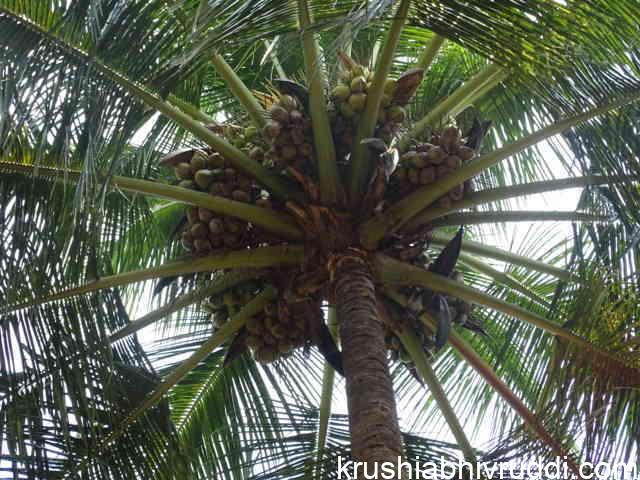The shape of the coconut palm is the mirror of its health. Every grower can assess whether this palm is healthy or not. Here are the visible characteristics of a healthy coconut palm. The health of the coconut palm is an indicator of its yielding capacity. An expert can judge if this palm yields well.
An Umbrella-shaped crown is the main characteristic of the well-grown coconut palm. There are two types of varieties in coconut, which is Tall and Dwarf. Tall attain around 20-30 miters when it attains maturity stage. The Dwarf varieties are smaller and taller 10-15 meters high. Coconut palm leaf is the main indicator of its health. An adult palm carries 30-40 paripinnate leaves. The leaf consists of a central stalk. up to 6 meters long. with over 200 narrow and tapering leaflets of 1-1.5 meters in length in a row. The leaf stalk or petiole is strong and clasps the stem round up to half the circumference of it.
The shape of the coconut tree:
The high-yielding and healthy adult coconut palm shape are like opened umbrella shape. All lower leaves are half bent 137 D towards the stem. It is the primary indicator of the good health of coconut trees. In this shape, the bunch of nuts will rests on the leaf stem. An adult palm has 4 sets of leaves. In a healthy regular-bearing tree, the first set consists of the oldest 10-12 leaves forming the lower whorl with the stumps of harvested bunches in this exile. The second set consists of 10-14 leaves from the middle whorl carrying fruit bunches in the successive stages of development. The third set consists of 10-12 leaves with spadices in various stages of development in their axils. The last set is composed of leaves in the bud or a half-opened umbrella shape. The outermost ones will just be unfurling while the youngest one appears in the center of the crown. The different sets of leaves occupy about 2.5 meters of the stem in an ascending spiral.

Sunlight and coconut palm:
Coconut tree requires full-day sunlight. In this condition only it fulfills all the above characteristics. The nature of the tree is growing towards the sunlight. Because of sunlight scarcity trees become curved to search for sunlight. Any tree that covers the crown growth will be hindered. After removing the shade it will become healthy. Injury to leaves will affect the yield. The growth of leaves is in all directions. If one direction gets shade it will bend opposite side. Leaf arrangements are also in different directions. The top-position leaves are a rapid rate of Co2 absorption compared to lower leaves. Leaves are opening in shorter intervals in September to November than in any other part of the year. If there is more number of leaves its yielding capacity is more. In healthy trees, ripened leave are dropped every month intervals. The life span of the leaf from its emergence to shedding is around 2.5-3 years. Every three to four weeks new leaf will emerge in the tree. Trunk of the palm is 30-40 cm. In the growing period, any decrease in stem girth is an indication of a shortage of nutrients ao water stress. If there is sufficient sunlight the internode between every leaf is less.

The yield:
A coconut tree can produce yearly 12-15 inflorescences. Among them few fail to develop or abort during development. It is because of unfavorable circumstances. The inflorescence of the healthy palm is around 1.1.2 meters in length and 14-16 cm in diameter in the middle portion. After appearing the inflorescence it will take around 75-90 days to open. The initiation of inflorescence at the leaf axil is about 32 months before opening. The agronomical treatments done in that period will be the outcome of the inflorescence.
Coconut requires heavy nutrient intake. So we have to provide sufficient nutrition continually. Required water and organic or chemical fertilizers should be given at in right time and right quantity. Then only we can get a good yield and maintain the health of the tree.











